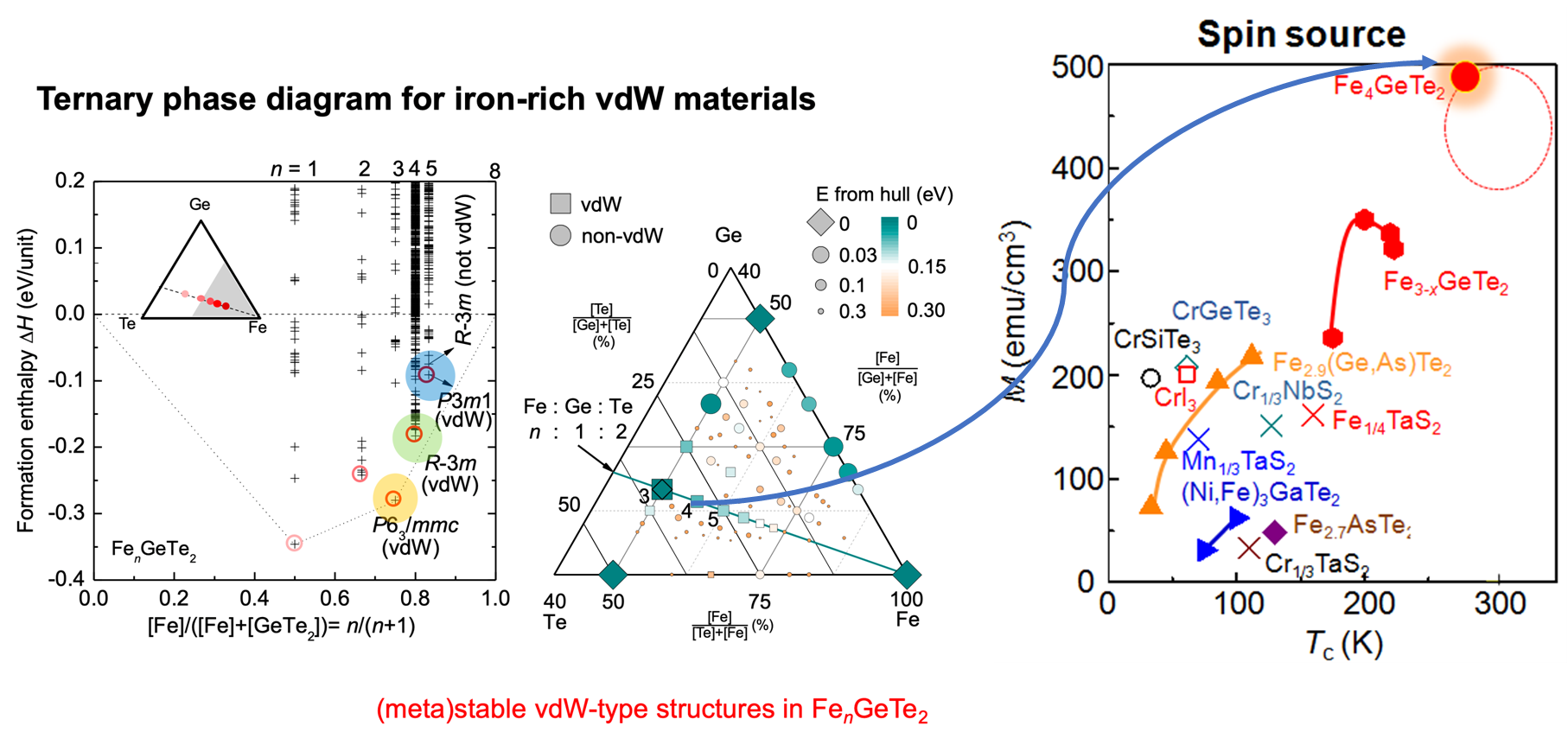Near room-temperature 2D ferromagnetic metal – Dr. Duckyoung Kim
JANUARY 18, 2020
New study from a team of scientists co-led by Dr. Duckyoung Kim from HPSTAR synthesized a new iron-based 2D ferromagnetic metal material, Fe4GeTe2 with the help of theoretical design. This new 2D ferromagnetic metal shows a nearly room temperature ferromagnetic order, together with a large magnetization and high conductivity and these properties could be retained in cleaved crystals down to seven layers. Their study highlights that Fe4GeTe2 and its nanometer-thick crystals as a promising candidate for spin source operation at nearly room temperature and hold promise to further improves the magnetic properties of vdW ferromagnets by theory guide. The work is published in the recent issue of Science Advances (DOI: 10.1126/sciadv.aay8912).
Spintronics has been regarded as a next generation platform for devices carrying information. It possesses superior characteristics over charge-based device due to its less energy loss and faster information carrying ability. Especially, two dimensional novel materials combined with strong ferromagnet nature have been a hot issue because they can make it possible to design a light, transparent, and flexible device. However, most researches have been focused mainly on semiconducting materials and they exhibited very low ferromagnetic transition temperatures, which have been a bottleneck of 2D spintronics.
Recently, Fe3GeTe2 got a lot of attention due to its very high transition temperature near 220 K as well as its itinerant electronic structure. “In Fe3GeTe2, Te plays as a holder of van der Waals interaction by sandwitching Fe and Ge atoms where Fe is the source of ferromagnetism in the compounds,” said Dr. Duckyoung Kim. “So it is reasonable to guess that increase of Fe density will lead increase of Tc (ferromagnetic transition temperature).
In this study, first they used structure prediction approach to Fe-Ge-Te compounds to search for stable iron-rich candidates and identified Fe4GeTe2 is likely to be formed. Dynamic Mean Field Theory (DMFT, it gives the most accurate description of electron-electron correlation effect in transition metals) predicted that a very high Tc of Fe4GeTe2.
With the guide from theoretical predictions, then the team carried out much work in experiments to synthesize and identify the novel compound, and eventually they clearly showed a stabilized stoichiometric Fe4GeTe2 for the first time.

Capion: (Left): Fe-Ge-Te ternary phase diagram and (meta)stable vdW-type structures; (Right):Magnetic properties and Tc of Fe4GeTe2 in comparison with other vdW ferromagets.
Their further magnetic and transport property measurements revealed a ~270K, nealy room-temperature Tc in Fe4GeTe2. And at this Tc, Fe4GeTe2 shows a much larger conductivity than other insulating vdW ferromagnets and comparable to that of the recent found Fe3GeTe2. What’s more , they found that the high Tc and conductivity could well be retained in nanometer-thick Fe4GeTe2 flakes.
“In comparison with other vdW ferromagnets or intercalated vdW ferromagnets reported so far, Fe4GeTe2 shows high Tc and high saturation magnetization and, thus, is only a vdW candidate, satisfying the most of requirements,” said Dr. Duckyoung Kim.
“It is worth to mention that this work is a rare example reporting a successful set of studies — computational materials design, predict magnetic property using cutting-edge computational work, and synthesize the real material useful to next generation material science,” added Dr. Duckyoung Kim.
在自旋电子材料中,二维范德瓦尔斯晶体由于其潜在的长程自旋输运及自旋控制方面的应用而受到人们的广泛关注。然而要实现其在自旋电子器件上的实际应用,我们必须获得室温下的铁磁性能。北京高压科学研究中心的Duckyoung Kim研究员与韩国Junho Seo教授, Eun Su An教授共同带领的研究团队通过理论预测指导并实验合成了新型富铁范德瓦尔斯材料,Fe4GeTe2。他们发现Fe4GeTe2具有接近室温(~270K)的铁磁转变温度,并且兼具高的磁化强度及电导率。他们的研究指出Fe4GeTe2有望用于接近室温下的自旋电子应用,并指出前沿的理论计算将为实验合成下一代能源材料提供重要的指导 。相关研究发表云近期的 Science Advances。
